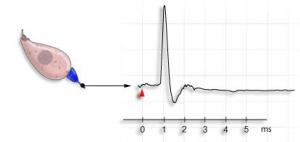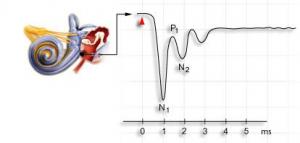Tous droits réservés © NeurOreille (loi sur la propriété intellectuelle 85-660 du 3 juillet 1985). Ce produit ne peut être copié ou utilisé dans un but lucratif.
Hearing thresholds of an individual may be assessed by both objective and subjective methods. Objective methods are based on recordings of the electrical activity at various stages along the auditory pathway, from the cochlea to the cortex, and do not need the active participation of the individual. On the other hand, subjective methods need the co-operation of the individual being tested, because they rely on the subject's perception of and response to sound.
Objective methods
Auditory potentials reflect the electrical activity of the various neural pathways involved in the coding of sounds. Individual unitary potentials are recorded directly from a single cell or nerve fibre. Compound potentials, recorded at a distance from their origin, reflect the sum of the unit potentials.
The following are three examples of different types of potentials : note the temporal concordance beween the different recordings - at whichever level being measured, the first wave recorded with a latency of 1 ms reflects the auditory nerve action potential. Recording acoustic otoemissions is also an objective method, which specifically allows to check outer hair cells motile properties.
| |
Unit action potentials (experimental technique not used in humans) A micro-electrode (black arrow) records electrical activity from a single neurone in the auditory nerve. This auditory fibre responds to sound stimulation (red dot) by sending an action potential (AP) towards the brain. The latency between the sound stimulus (red arrow) and the the AP is about 1ms. |
Brainstem Auditory Evoked Potentials (BAEPs)
Surface electrodes placed on the skull allow recording of 5 main waves of electrical activity through the brainstem. Wave I, with a latency of 1 ms, reflects the auditory nerve potential ; waves II to V reflect processing centres in the auditory system.
These potentials are of very weak amplitude (< µV) and therefore averaging of many repeat stimulations (1000 to 2000) is required, in order to be able to differentiate them from background noise. After these early evoked potentials, the same skull electrodes can record later potentials from activity in the thalamocortex (middle latency and cortical auditory evoked responses).
Subjective methods (Audiograms)
Tonal audiogram
Pure tone audiograms recorded in a normally-hearing subject over the course of their life. Each curve represents the average hearing loss as a function of age.
(see pathology / presbycusis)
Note: each one of these methods is further developed in specific pages
 Français
Français
 English
English
 Español
Español
 Português
Português







Facebook Twitter Google+